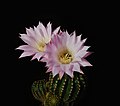| Echinopsis oxygona | |
|---|---|

| |
| Scientific classification | |
| Kingdom: | Plantae |
| Clade: | Tracheophytes |
| Clade: | Angiosperms |
| Clade: | Eudicots |
| Order: | Caryophyllales |
| Family: | Cactaceae |
| Subfamily: | Cactoideae |
| Genus: | Echinopsis |
| Species: | E. oxygona |
| Binomial name | |
| Echinopsis oxygona (Link) Zucc. ex Pfeiff. & Otto | |
| Synonyms | |
List
| |
Echinopsis oxygona, also known as Eyries cactus, Easter lily cactus or sea-urchin cactus, is a species of flowering plant in the cactus family Cactaceae, native to south Brazil, Uruguay, Paraguay and northeastern Argentina. Some species that have been described separately, including Echinopsis eyriesii and Echinopsis tubiflora, are now considered to be synonymous. The features of the species include a large flower, with sharply pointed lavender or white petals, and a sweet scent.
Description
Echinopsis oxygona grows singly or in groups. The spherical to short cylindrical, dark green shoots reach heights of up to 75 cm (30 in) with a diameter of up to 15 cm (5.9 in). There are 8 to 18 ribs. The white to tan, gray or black areoles are up to 2 cm (0.79 in) apart. The spines that emerge from the areoles vary in size and number. In plants that have been treated as E. eyriesii, there are 10–15 very short spines. In plants that have been treated as E. oxygona, the spines are longer: the one to five strong central spines are up to 3–3.5 cm (1.2–1.4 in) long, and there are up to 20 thinner radial spines up to 2.5 cm (1.0 in) long. Plants produce white, lavender or pale red flowers that open at night. The flowers are up to 25 cm (9.8 in) long and up to 10 cm (3.9 in) across.
-
 Replanted plants with young offsets
Replanted plants with young offsets
-
 Plant with long spines
Plant with long spines
-
 Plants with short spines have been described as E. eyriesii
Plants with short spines have been described as E. eyriesii
Habitat
Echinopsis oxygona, native to Southern Brazil, Uruguay, Paraguay and Entre Ríos Province, Argentina, thrives in lowland environments, reaching altitudes of up to 1,000 meters above sea level. In these areas, there is a tropical and continental climate, characterized by arid winters and humid summers. The annual precipitation in these regions amounts to approximately 1,500 mm, sustaining an average annual temperature range of 25–30°C, rarely dropping below zero degrees.
Cultivation
Echinopsis oxygona is known for having huge, showy flowers at the ends of long tubes which are connected to the cactus. The flower has a sweet smell. The flower opens in the evening and wilts the next afternoon on hot days. It grows well in full sun, or light shade. These cacti can stand strong heat, and even temperatures as low as −10 °C (14 °F). Usually these are outdoor plants. They are used to the dry, desert climate, so they do not need to be watered every day.
In the 19th century, Echinopsis oxygona was extensively hybridized with other Echinopsis and Lobivia species, giving rise to a number of cultivars with large colourful flowers.
In cultivation in the UK this plant has received the Royal Horticultural Society's Award of Garden Merit.
Propagation
Usually, the cactus will start to have small offsets appear at its base. These can be plucked off and transplanted into a different pot for further growth into a mature cactus. Usually, the cactus will bloom in mid summer.
References
- ^ "Echinopsis oxygona (Link) Zucc. ex Pfeiff. & Otto". Plants of the World Online. Royal Botanic Gardens, Kew. Retrieved 8 November 2024.
- ^ Anderson, Edward F. (2001). The Cactus Family. Pentland, Oregon: Timber Press. ISBN 978-0-88192-498-5. Pages 265–266, 285.
- Anderson, Edward F.; Eggli, Urs (2005). Das grosse Kakteen-Lexikon (in German). Stuttgart (Hohenheim): Ulmer. p. 238. ISBN 3-8001-4573-1.
- "Echinopsis oxygona". Ilife: encyclopedia of living forms; The Encyclopedia of Cacti. Retrieved 8 November 2024.
- "Echinopsis eyriesii (Turpin) Pfeiff. & Otto". Ilife: encyclopedia of living forms; The Encyclopedia of Cacti. Retrieved 5 December 2024.
- "Echinopsis oxygona". www.rhs.org. Royal Horticultural Society. Retrieved 5 June 2020.
External links
| Echinopsis | |
|---|---|
| Taxon identifiers | |
|---|---|
| Echinopsis oxygona |
|
| Echinopsis eyriesii | |
| Echinocactus oxygonus | |
This Cactaceae article is a stub. You can help Misplaced Pages by expanding it. |



